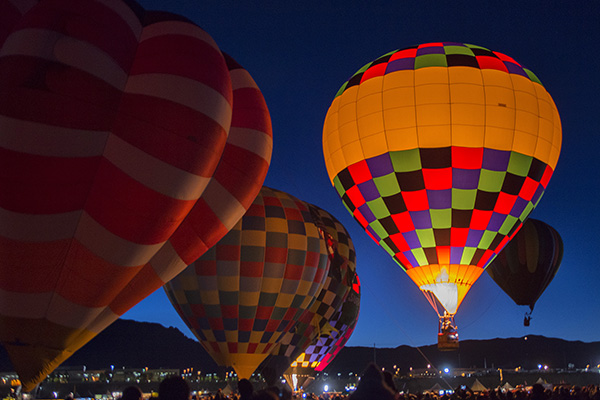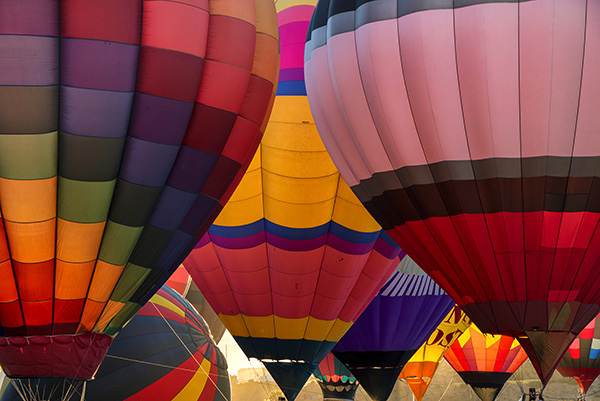By Jenn Gidman
Images by Ken Hubbard
For nearly half a century, the skies of Albuquerque have been inundated with hundreds of hot-air balloons each October. Since 1972, when the first Albuquerque International Balloon Fiesta was held with a mere 13 balloons, the seasonal event has grown into the biggest balloon fest in the world, featuring not only the main event, but also a rodeo, concessions, balloon memorabilia, and traditional New Mexican food.
Ken Hubbard had the chance to head to last year’s festival to capture the fanfare that accompanies the spectacular sky show. “On the weekends, the launches start before sunrise with the ‘Dawn Patrol,’ he says. “A select number of pilots (10 to 12 when I was there) launch in the dark before anyone else to test the wind intensity and directions. It’s a really awe-inspiring sight to see all of the balloons slowly being inflated in the dark. Then, once they’re filled with enough hot air, the flames shoot into the balloons themselves, showing off all of the colors and designs. While this is going on, balloons are being laid out all across the 80-acre field for the mass ascension, which takes place over the next couple of hours, with more than 500 balloons launching into the sky.”

28mm, F/3.5, 1/30th sec., ISO 1600
I wanted to capture the single balloon being lit as it rose above the rest that weren’t. I took a few images with the balloons that were still on the ground being lit, but I felt it was a bit more effective with them still dark.
Here are Ken’s quick and easy tips on how to best capture such a colorful, fun event.
How to prepare
Since I’d never been to the Fiesta before, I packed my backpack as I usually do, trying to think of everything I would need, including a tripod, flash, flashlight, and polarizers. As far as lenses go, I included everything from an ultra-wide to a long telephoto.
All I ended up using was the Tamron 28-300mm VC PZD lens. This was one of the most fast-paced, controlled-chaos events I’d ever tried to photograph. Since there were images that could be taken every second of every minute in all directions, I never took off the first lens I put on my camera, which was that 28-300. It’s so lightweight and small that my arms never got tired, and I was able to move quickly between images—from zooming into balloons that were far away to capturing wide-angle images while leaning into the baskets and shooting straight up as the flames filled the balloons.
I had a tripod strapped to my bag the entire time while on the field, but I didn’t use it once. There are tens of thousands of people at the festival, and trying to put up a tripod would have just gotten in my way and everyone else’s way.
Where to stand
There’s no one vantage point for capturing images at the Fiesta. My advice is to get plenty of rest, wear comfortable clothes and shoes, and be prepared to walk quickly and, at times, a lot. Since balloons are being launched from every part of the field, you’ll want to try and capture as much of the scene as possible. I’d say I went up and down and side to side on this field three or four times by the time the last of the balloons had lifted off.
How to adjust for the constantly changing light
We started in the predawn hours, with the only light being the glow from the balloons. Fortunately, they give off a lot of light. To keep noise to a minimum, I started with an ISO of 1600 and then opened my aperture to F/4, giving me a shutter speed of about 1/30th of a second. As the sky began to lighten, I slowly started bringing my ISO down to 800, then 400. Finally, when the sun rose above the horizon, I shot at ISO 200, with a stopped-down aperture of F/16 giving me a shutter speed of around 1/100th of a second. Since I wanted to make sure the balloons were always properly exposed, I used center-weighted metering, which helps the camera meter just for the main subject.
How to compose your images
Unique compositions are possible everywhere you look during the festival, especially once the balloons have risen into the air. Some general tips:
• There will be so much going on, from 20 balloons being freshly laid out on the lawn waiting to be filled, to those same balloons in the air side-by-side, bouncing off one another. You may get a little overwhelmed and just start to fire away at will, hoping to capture something decent. It may be difficult to do at first, but try to slow down and focus on more eye-catching compositions and where the best light is. Remember the basics and you’ll capture amazing images.
• One of my favorite things to do is to use strong foreground elements to complement the background balloons.
• Shoot as much as possible from every angle: below the balloons, next to them, wide angle, and telephoto. To me, it was like shooting a sporting event: The more you shoot, the better chance you’ll get great images. Don’t hyperfocus on how many images you shoot, though, and if the ratio of good images to bad is low. That takes away from the fun of it all!

38mm, F/4, 1/30th sec., ISO 1600
This was a tough shot because I was to the left of these balloons as they first started to launch. I had to race in between the balloons to make it to the other side just in time as a burst of flame lit the balloon. It ended up casting nice, soft light onto the ones still on the ground.

95mm, F/13, 1/60th sec., ISO 200
I wanted to capture how close together the balloons were and the beautiful gold color behind them. So I zoomed in a little, to about 95mm, cropping off the tops of the balloons to help create the closed-quarters look I was going for.

78mm, F/11, 1/125th sec., ISO 200
The tough part was trying to show all of the balloons in the sky and giving the whole scene some scale, so I zoomed to about 78mm to crop tightly to the balloon on the right but still kept all of the other balloons in the background in the frame.

70mm, F/18, 1/80th sec., ISO 200
This image is all about framing. I took the two balloons that were closest to me and used the space between them to frame the two in the background.

78mm, F/11, 1/200th sec., ISO 200
As the sun came over the horizon, I started to capture images of the balloons that were being backlit by the sun. Most of the balloons are extremely colorful and beautiful as is, but when you add the glow from the sun streaming through them, the colors become much more vibrant.